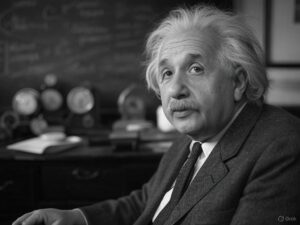
In the bustling city of Bern in 1905, a young Albert Einstein sat at his desk in the patent office, surrounded by stacks of papers and the humdrum of clerical work. The world outside continued its steady march into the 20th century, unaware of the absence of a groundbreaking theory that would have reshaped its understanding of the universe. Without the Theory of Relativity, the trajectory of scientific discovery took a different path, altering the course of history in ways both subtle and profound.
In this alternate timeline, physicists grappled with the limitations of classical mechanics, struggling to reconcile the behavior of light and gravity within the Newtonian framework. The concept of spacetime, a revolutionary idea that would have unified space and time into a single continuum, remained an unformulated mystery. As a result, the scientific community became increasingly fragmented, with competing theories vying for dominance, yet none providing a satisfactory explanation for the anomalies observed in the motion of planets and the peculiarities of light.
Without Einstein’s insights, the development of quantum mechanics also took a different turn. The absence of relativity as a guiding principle meant that early quantum theorists lacked the conceptual tools to fully explore the implications of their discoveries. The famous debates between Niels Bohr and Albert Einstein never took place, and the Copenhagen interpretation of quantum mechanics emerged without its most vocal critic. This led to a more deterministic view of the quantum world, with alternative interpretations gaining traction in the absence of Einstein’s influence.
As the scientific community struggled with these challenges, the world outside continued to advance technologically, albeit at a slower pace. The lack of a unified theory of relativity meant that certain technological innovations, such as GPS, which relied on precise calculations of time and space, were delayed by decades. Space exploration, too, faced significant hurdles. Without the understanding of relativistic effects, early space missions encountered unexpected anomalies, leading to costly setbacks and a more cautious approach to venturing beyond Earth’s atmosphere.
Meanwhile, the political landscape of the 20th century unfolded with its own unique twists. The absence of Einstein’s theory meant that the Manhattan Project, which relied on the understanding of mass-energy equivalence, took longer to reach fruition. The atomic bomb was developed later than in our timeline, altering the course of World War II and the subsequent geopolitical balance. The Cold War, while still a defining feature of the era, played out differently, with nuclear arms development proceeding at a slower pace and the space race taking on a different character.

In this world, the scientific community remained divided, with no single figure emerging to unify disparate theories into a coherent framework. This fragmentation led to a proliferation of alternative theories, each with its own adherents and detractors. Conferences and symposia became battlegrounds for competing ideas, with passionate debates and occasional breakthroughs that hinted at the elusive truth.
As the century drew to a close, a new generation of physicists, inspired by the mysteries that still eluded them, embarked on a quest to uncover the fundamental nature of the universe. Among them was a young scientist named Lila Patel, who had grown up fascinated by the stars and the unanswered questions that lay beyond. Driven by curiosity and a determination to solve the puzzles that had confounded her predecessors, Lila delved into the archives of forgotten theories and obscure papers, piecing together a new understanding of the cosmos.
In a groundbreaking paper published in the early 21st century, Lila proposed a radical new theory that synthesized elements of classical mechanics, quantum theory, and the fragmented remnants of relativity. Her work sparked a renaissance in physics, drawing together disparate strands of thought into a cohesive whole. The scientific community, long divided, rallied around her ideas, ushering in a new era of discovery and innovation.
With this newfound understanding, humanity embarked on a journey of exploration and technological advancement that had once seemed impossible. Space travel became routine, with missions to Mars and beyond becoming a reality. The mysteries of black holes and the nature of dark matter, once shrouded in uncertainty, began to yield their secrets. The world, united by a shared sense of wonder and possibility, looked to the stars with renewed hope and determination.
In this alternate history, the absence of Einstein’s Theory of Relativity had delayed humanity’s progress, but it had also fostered a spirit of collaboration and resilience. The challenges faced by generations of scientists had forged a community that valued diversity of thought and the pursuit of knowledge above all else. As humanity reached for the stars, it carried with it the lessons of the past, determined to build a future that celebrated the power of imagination and the boundless potential of the human spirit.




